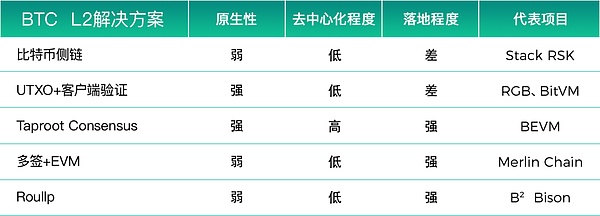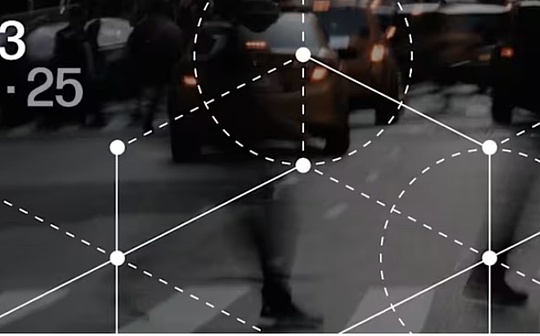
Source: web3 Chinese
Today, BTC Layer2 project BEVM officially announced the completion of the seed round and some A rounds of US$10 million in financing, with a post-investment valuation of US$200 million, becoming a dazzling star in the BTC Layer2 track.Since the beginning of 2024, BTC Layer2 has become the biggest hot spot in the crypto market. Various BTC Layer2 projects have also emerged first, and the Bitcoin layer two solutions selected for each project are also different.Today we will explain the differences between various BTC L2 solutions on the market through an article.
Currently, various BTC L2 solutions on the market are diverse and complex.From the perspective of technical implementation, it can be roughly divided into five categories: Bitcoin sidechain, UTXO+ client verification, Taproot Consensus, multi-signature + EVM, and Roullp.We will analyze the advantages and disadvantages of these five types of Bitcoin L2 solutions from the perspectives of Bitcoin nativeness, decentralization and implementation.
Why do we need to analyze it from the perspectives of Bitcoin’s nativeness, decentralization and implementation?
First: No changes to the Bitcoin code, but directly use the mature and time-verified Bitcoin native technology to build BTC L2, which can not only minimize risks and eliminate uncertainty, but also the Bitcoin reflected hereNativeness and the following of Bitcoin’s original purpose basically determine whether it can be recognized by the mainstream Bitcoin community, which is of far-reaching significance for the launch and development of the BTC L2 project.
Second: Decentralization is the spiritual core of blockchain.In the Bitcoin community with decentralization as its core culture, whether a BTC L2 is decentralized enough almost determines the life and death of the project.The decentralization of BTC L2 is directly reflected in whether the management and entry and exit costs of BTC are safe. A BTC L2 that cannot safely manage BTC in a decentralized way cannot obtain the support and trust of BTC users.Therefore, decentralization is a core proposition that all BTC L2 must face.
Third: BTC L2 has been developing for 6-7 years, and many solutions sound sexy, but the reality is cruel, from the earliest Stack and RSK to RGB that has been proposed for four years, including after the release of the white paper, there is no more sound to BitVM.The implementation situation is basically the most direct way to test solutions.Therefore, the implementation of various BTC L2s should be one of the important indicators for us to measure the pros and cons.
1. Bitcoin side chain:
Bitcoin sidechain refers to an expansion blockchain that can exist independently of Bitcoin. For example, Stack and RSK are both Bitcoin sidechain solutions.Bitcoin side chains generally use multi-signal or Hash Lock to manage Bitcoin. At the same time, BTC is mapped on the second-layer blockchain, so that BTC has the ability to expand complex scenarios at the second-layer.
1. Bitcoin Nativeness:
The Bitcoin sidechain solution can be simply understood as multi-sign + VM blockchain, and these Bitcoin sidechains can exist independently of Bitcoin, so Bitcoin is poorly native, so it is difficult to obtain support from the Bitcoin community..
2. Decentralization degree:
Since Bitcoin side chains generally adopt multi-signature and hash lock solutions to achieve Bitcoin management, the degree of decentralization is generally poor, and the security of assets depends entirely on multi-signature users.
3. Degree of landing:
Bitcoin sidechain solution has been born for many years, but neither Stack nor RSK have achieved great results in ecological development. The core reason is that the degree of decentralization of the chain and asset security issues have not been solved, so it is difficult to obtain.Trust of users and funds.
2. UTXO+ client verification
UTXO+ client verification refers to an expansion plan based on the Bitcoin UTXO account model. This plan is generally based on Bitcoin UTXO to perform the account calculations of the Bitcoin chain, and at the same time, the client verification method is used to ensure the authenticity of the ledger., which has both the native nature of Bitcoin and can also play the goal of sharing Bitcoin ledger security in the second-tier ledger.The UTXO+ client verification solution sounds sexy, but the reality is cruel and it is extremely difficult to implement.Because, in the minimalist Bitcoin UTXO account model that does not support complex operations, it is difficult to insert “extra tasks” to ensure the security of the second-layer ledger. Whether this model is feasible remains to be verified.Typical representatives of this type of project are: RGB and BitVM
1. Bitcoin Nativeness:
UTXO+ client verification focuses on Bitcoin nativeness, which is entirely based on UTXO. However, due to the overemphasis on nativeness, it is extremely difficult to implement, and it seems to be heading to another extreme.Originally, we wanted to expand Bitcoin, but it was becoming more and more complicated.Moreover, the essence of client verification is to hand over the security verification problem to users, and return to the most primitive and least efficient single-body verification model.Often, overemphasis on nativeness may ignore feasibility and practicality.
2. Decentralization degree:
Due to the UTXO model-based solution, although it seems that the Bitcoin blockchain is used to ensure the trustworthiness of the second layer, in essence, it still uses the off-chain method of client verification. Although the client can be sufficiently scattered and sufficiently scattered.Centralization, however, this point-to-point verification model is not a decentralization that relies on network consensus, but a distributed verification that relies on decentralized number of clients.This model often depends on the client’s own verification ability. Assuming that some clients do not have enough understanding of the verification model or have problems with the verification method, they are likely to face problems such as asset loss and double spending of assets.It is hard to say that it is a truly feasible decentralized solution.
3. Degree of landing:
It has been four years since RGB was proposed, and BitVM has been proposed for a year, but they are still in the white paper or theoretical stage. RGB still has no testable version, and BitVM has not made any clear progress since the release of the white paper.Some projects that claim to be built on RGB and BitVM have also stopped or found another way out.It can be seen that the expansion solution of UTXO+ client verification still faces huge uncertainty.
3. Taproot Consensus
Taproot Consensus is a second-layer solution built on the three native technologies of Bitcoin. It is a solution that has gradually matured since Bitcoin’s Taproot upgrade in 2021.The essence of Taproot Consensus is Schnorr Signature+MAST Contract+Bitcoin Light Node Network.
Schnorr Signature allows Bitcoin multi-signature addresses to expand to 1,000, realizing the decentralization of multi-signature addresses; MAST Contract implements the codeization of multi-signature management, not relying on people to sign, but relying on code-driven; Bitcoin Light Node Network implementsRelying on Bitcoin’s light node network consensus to drive multiple signs, the decentralized Bitcoin cross-chain and management is fully realized.
Taproot Consensus is a solution proposed and implemented by the BEVM team. BEVM is also a typical use case of Taproot Consensus.
1. Bitcoin Nativeness:
Taproot Consensus is completely built on the three native technologies of Bitcoin. It has not introduced or added any other technologies outside of Bitcoin. It is a solution for Bitcoin’s 2021 Taproot upgrade and a comprehensive solution for Bitcoin’s multiple core technologies.Therefore, Taproot Consensus is extremely native and has high grounding ability.After all, whether it is Schnorr Signature, MAST Contract, or Bitcoin Light Node Network, are mature technologies that have been proven for many years in Bitcoin’s history.Including, the core behind Ordinals is to rely on MAST Contract.
It is worth mentioning that since the nodes of the Bitcoin Layer 2 network based on Taproot Consensus are all Bitcoin light nodes, the layer 2 network cannot exist independently of Bitcoin and has an inseparable dependency with Bitcoin.
2. Decentralization degree:
The core of Taproot Consensus is to solve the decentralized entry and expenditure of Bitcoin, which is the most core proposition of all Bitcoin L2.Taproot Consensus can realize fully decentralized Bitcoin management through a BFT consensus network composed of 1,000+ Bitcoin light nodes, thereby solving the problem of BTC introducing it into the second-layer network in a trustless manner, and ultimately realizing Bitcoin expansion.
3. Degree of landing:
The second-layer Bitcoin solution of Taproot Consensus has been proposed in 2021 and has been implemented in July 2023. The BEVM pioneer network built on Taproot Consensus has been operating stably for 8 months, processing 6 million transactions, and 100,000 on-chain users, 30+ ecological projects, and the BEVM main network based on Taproot Consensus has been launched on the main network recently.Therefore, Taproot Consensus is currently the second-tier Bitcoin solution with a high degree of implementation.
4. Multiple signs + EVM
Multi-signature + EVM is the solution adopted by many BTC L2. Whether it is using MPC multi-signature solution, threshold signature solution, or Hash Lock, DLC and other solutions, it is essentially a multi-signature + EVM solution.Users step BTC into multi-sign address and then generate new BTC on the EVM chain, thus making BTC activities compatible with the capabilities of EVM smart contracts.
This kind of solution is the simplest to implement and the technical threshold is very low. However, in essence, this kind of solution is still a Bitcoin sidechain solution, but the implementation method is simpler and more crude than the sidechain.该类型的项目典型是Melin Chain等。
1、比特币原生性:
Solutions like multi-signal + EVM have no nativeity.The essence is to save Bitcoin in a multi-sign address and map a new BTC asset to run on layer 2.Moreover, the second-tier blockchain can exist completely independent of Bitcoin.
2、去中心化程度:
The essence of multi-signing is to trust multiple signers and multi-signing mechanisms, not trust network consensus.Therefore, the asset security of the Bitcoin layer 2 solution of multi-signature + EVM completely relies on the multi-signature or private key holder specified by the project party.并没有太多的去中心化共识。
3、落地程度:
The solution of multiple sign + EVM is very easy to implement. A multiple sign wallet + an EVM-compatible blockchain is not a very complex technical problem, and there are many open source versions, so the cost of starting a business is the lowest, so the market isThe large number of so-called Bitcoin layer 2 solutions visible on it all use this kind of solution.However, this kind of solution is very challenging to manage multiple signers, after all, the security of assets depends on these multiple signers.
5. Roullp
Whether it is ZK-Roullp or OP-Roullp, they are originally solutions for Ethereum L2, but many entrepreneurs borrow Roullp to Bitcoin L2 solutions.But is it really feasible to run roundp on Bitcoin?Ethereum essentially supports smart contract verification, and Ethereum can also verify the RoullP ledger information of the second layer. Therefore, Ethereum RoullP layer 2 can share the security of Ethereum, but Bitcoin essentially does not support any form of RoullP verification.of.
Therefore, forcibly introducing roundp to Bitcoin is essentially invalid. BTC L2 of rollup solution. Therefore, client verification or self-built DA layer is often introduced to verify roundp.This is equivalent to a circle, and Bitcoin only saves the ledger of Roullp itself. However, if it does not verify, the verification will still be handed over to the client or the DA layer built by the BTC L2 project party. Then, the security of the BTC L2 project itself isIt became the key to all problems.Typical representatives of this type of project are: B2 and Bison.
1. Bitcoin Nativeness:
The essentials of the Roullp solution come from the second layer solution of Ethereum. The essence of the Roullp is about how to achieve credibility in the second layer ledger. It has nothing to do with Bitcoin in essence. The Bitcoin blockchain only serves as an proof but does not.Verified role.Therefore, Roullp is poor in nature and is basically difficult to obtain support from Bitcoin core users.
2. Decentralization degree:
The decentralization of BTC L2 mainly involves two aspects. On the one hand, it involves the decentralization of asset management and the decentralization of the second-tier ledger.The Roullp solution generally adopts a multi-signal solution for the first layer of Bitcoin asset management, while the second layer uses a sorter solution. Currently, most Ethereum sorters are centralized and are the nodes of the L2 project party.to run the sorter.At present, most BTC L2 with Roullp as the core solution still does not solve these two decentralization problems.
3. Degree of landing:
Since the Roullp solution is mature in the Ethereum ecosystem, it is not complicated to implement at the second level of Bitcoin, and many chains use the multi-signal method to implement Bitcoin management, so the overall implementation is not difficult.At present, the user scale and TVL of BTC L2 projects such as B2 have also begun to take shape.However, for this type of project, there are still two major challenges in the market. The first is the issue of Bitcoin asset management and the credibility of the second-tier ledger.
Summarize:
From the three dimensions of Bitcoin nativeness, degree of decentralization and degree of implementation, the five major BTC L2 solutions have their own advantages and disadvantages.

The development results of the Bitcoin sidechain solution over the years have also verified that it is almost difficult to obtain support and recognition from mainstream Bitcoin users; in terms of entrepreneurship difficulty, multi-sign + EVM is the easiest solution to replicate, which is the core test of the project party’s market.and marketing capabilities, however, in the long run, due to the low degree of decentralization, it is difficult to obtain the support and trust of large Bitcoin funds in the long run, and the sustainability of project development remains to be seen.
From the perspective of Bitcoin nativeity, the UTXO+ client verification model is the most native and halal, but the technology implementation is too complex, and in the short term, it is extremely difficult to implement; the Roullp solution directly borrows the Ethereum L2 solution and speech,Although the fundamental problem of BTC L2 has not been solved, the cost of brand communication is low. If long-term development is to be achieved, the problem of decentralization must still be solved.
Taproot Consensus solution, since it directly uses Bitcoin native technology to build a decentralized BTC L2 solution, Taproot Consensus is currently in terms of Bitcoin nativeness and decentralization, including its current implementation.The most noteworthy BTC L2 solution.








